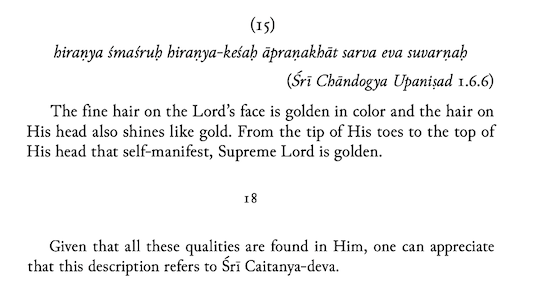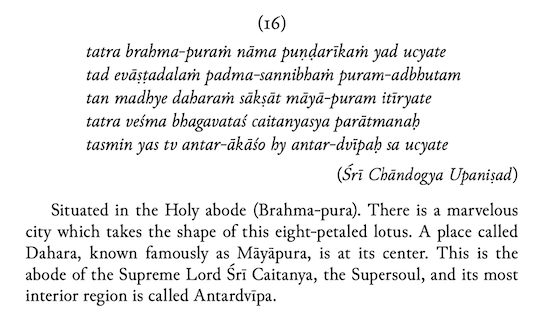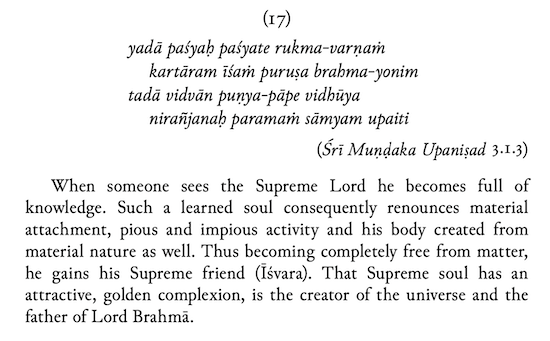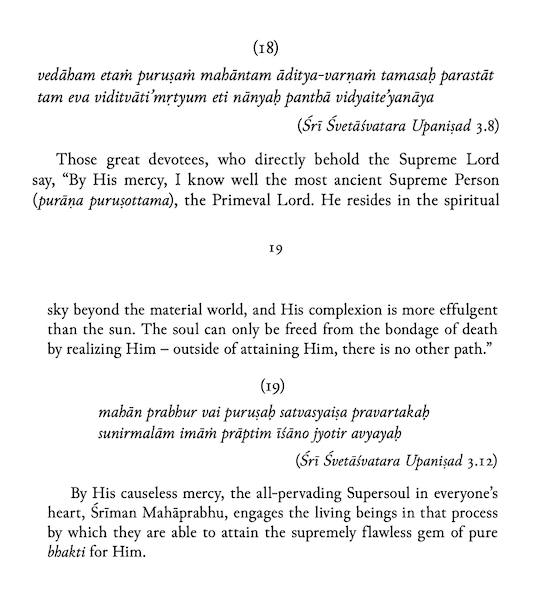Caitanya Mahaprabhu — Scriptural Proofs of His Avatarahood and Divinity. Part 5
 The fourteenth “proof” from the Kaṭhā-upaniṣad 2.1.13 is three words taken out of context. The complete mantra is as follows:
The fourteenth “proof” from the Kaṭhā-upaniṣad 2.1.13 is three words taken out of context. The complete mantra is as follows:
 Nārāyaṇa Mahārāja’s translation does little justice to the quote that says: “golden hair and a golden beard; is completely golden”. All other words of translation are a fitting of meaning to the desired result.
This section of the Upaniṣad deals with the sounds and mantra-s of the Ṛgveda and Sāmaveda; that they are earth and fire; that they are wind and sky, moon and sun; that they are lustre and darkness, etc. If Nārāyaṇa Mahārāja or those who compiled this book had not deliberately shortened the mantra and tried to pass off the mention of yellow colour as the colour of Gaurāṅga aka Caitanya, the reader would have seen a very different picture:
“Now, sā is the white luster of the sun and ama, the dark, the pitch-black — and that makes ‘Sāma.’
Now, the golden person we see within the sun — he has golden hair and a golden beard; he is completely golden, down to the very tips of his nails. His eyes are like deep blue lotuses. His name is ‘Up’ (ud), for he has risen up (udita) above all evils. Anyone who knows this undoubtedly rises up above all evils. The two songs (geṣṇa) of that golden person are the Ṛg and the Sāman. He is therefore the High Chant (udgītha), and, because he sings it, also the High Chanter (udgātṛ). He rules over the worlds beyond the sun and over the desires of gods.
That was with respect to the divine sphere.” (transl. by Olivelle)
Nārāyaṇa Mahārāja’s translation does little justice to the quote that says: “golden hair and a golden beard; is completely golden”. All other words of translation are a fitting of meaning to the desired result.
This section of the Upaniṣad deals with the sounds and mantra-s of the Ṛgveda and Sāmaveda; that they are earth and fire; that they are wind and sky, moon and sun; that they are lustre and darkness, etc. If Nārāyaṇa Mahārāja or those who compiled this book had not deliberately shortened the mantra and tried to pass off the mention of yellow colour as the colour of Gaurāṅga aka Caitanya, the reader would have seen a very different picture:
“Now, sā is the white luster of the sun and ama, the dark, the pitch-black — and that makes ‘Sāma.’
Now, the golden person we see within the sun — he has golden hair and a golden beard; he is completely golden, down to the very tips of his nails. His eyes are like deep blue lotuses. His name is ‘Up’ (ud), for he has risen up (udita) above all evils. Anyone who knows this undoubtedly rises up above all evils. The two songs (geṣṇa) of that golden person are the Ṛg and the Sāman. He is therefore the High Chant (udgītha), and, because he sings it, also the High Chanter (udgātṛ). He rules over the worlds beyond the sun and over the desires of gods.
That was with respect to the divine sphere.” (transl. by Olivelle)
 The author of the passage tried very hard to make it similar to the Chāndogya-upaniṣad mantra, but with “Gauḍīya” material. This can be seen at least by looking at mantra-s 8.1.1 and 8.1.2:
The author of the passage tried very hard to make it similar to the Chāndogya-upaniṣad mantra, but with “Gauḍīya” material. This can be seen at least by looking at mantra-s 8.1.1 and 8.1.2:
 The correct translation of this mantra is:
When the seer sees that Person,
the golden-colored, the creator, the Lord,
as the womb of brahman;
Then, shaking off the good and the bad,
the wise man becomes spotless,
and attains the highest identity.
As we can see the mantra speaks a little differently than Nārāyaṇa Mahārāja has presented it. There are no phrases in the mantra “he becomes full of knowledge”, “consequently renounces material attachment”, “his body created from material nature as well”, “Thus becoming completely free from matter”, “he gains his Supreme friend (Īśvara)”, “That Supreme soul has an attractive”, “the father of Lord Brahmā”.
The correct translation of this mantra is:
When the seer sees that Person,
the golden-colored, the creator, the Lord,
as the womb of brahman;
Then, shaking off the good and the bad,
the wise man becomes spotless,
and attains the highest identity.
As we can see the mantra speaks a little differently than Nārāyaṇa Mahārāja has presented it. There are no phrases in the mantra “he becomes full of knowledge”, “consequently renounces material attachment”, “his body created from material nature as well”, “Thus becoming completely free from matter”, “he gains his Supreme friend (Īśvara)”, “That Supreme soul has an attractive”, “the father of Lord Brahmā”.
 Translation of the mantra of the Śvetāśvatara-upaniṣad 3.8:
“I know that immense Person, having the color of the sun and beyond darkness. Only when a man knows him does he pass beyond death; there is no other path for getting there.”
Translation of the mantra of the Śvetāśvatara-upaniṣad 3.12:
“The Person, clearly, is the immense Lord. He is the one who sets in motion the real. The Imperishable One rules over the light, this totally flawless attainment.” (transl. by Olivelle)
The words “Supersoul” and “Sriman Mahaprabhu”, “pure bhakti” are missing from the mantra 3.12. Nārāyaṇa Mahārāja is wishful thinking. And here is a convenient occasion to claim that the words “mahān prabhur” — is Caitanya. This mantra was interpreted in favour of Caitanya as early as Bhaktivinoda Ṭhākura. We know from his biography that during the period of 1886 he was actively studying the Upaniṣads, their language, style and structure. The Caitanya-upaniṣad just appeared in 1887, as did most of the “proofs” of Caitanya’s avatārahood, which the founders and main ācārya-s of the school did not mention. The Gaudiya Maths and ISKCON continue to regard these “proofs” as authentic.
Translation of the mantra of the Śvetāśvatara-upaniṣad 3.8:
“I know that immense Person, having the color of the sun and beyond darkness. Only when a man knows him does he pass beyond death; there is no other path for getting there.”
Translation of the mantra of the Śvetāśvatara-upaniṣad 3.12:
“The Person, clearly, is the immense Lord. He is the one who sets in motion the real. The Imperishable One rules over the light, this totally flawless attainment.” (transl. by Olivelle)
The words “Supersoul” and “Sriman Mahaprabhu”, “pure bhakti” are missing from the mantra 3.12. Nārāyaṇa Mahārāja is wishful thinking. And here is a convenient occasion to claim that the words “mahān prabhur” — is Caitanya. This mantra was interpreted in favour of Caitanya as early as Bhaktivinoda Ṭhākura. We know from his biography that during the period of 1886 he was actively studying the Upaniṣads, their language, style and structure. The Caitanya-upaniṣad just appeared in 1887, as did most of the “proofs” of Caitanya’s avatārahood, which the founders and main ācārya-s of the school did not mention. The Gaudiya Maths and ISKCON continue to regard these “proofs” as authentic.

